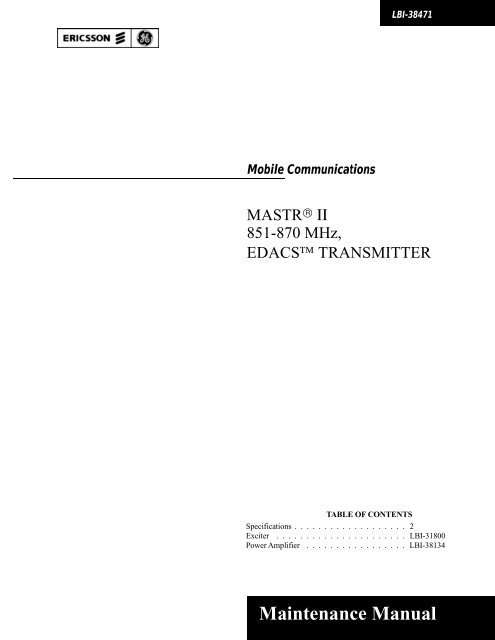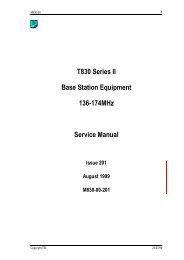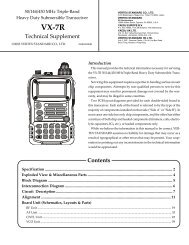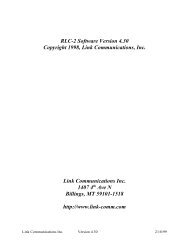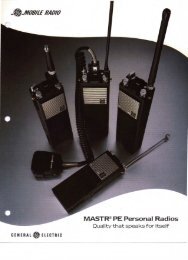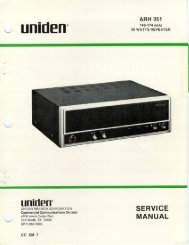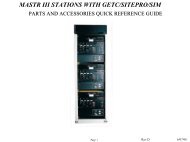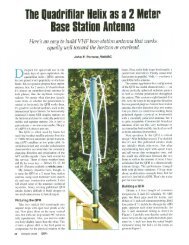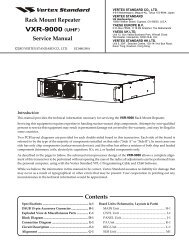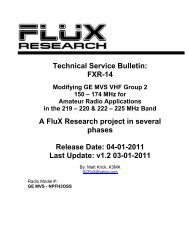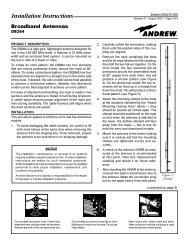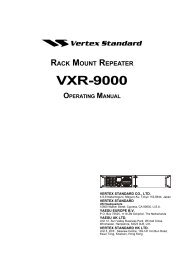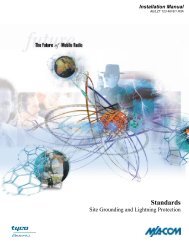LBI-38471 - MASTRII 851-870 MHz, EDACS TRANSMITTER
LBI-38471 - MASTRII 851-870 MHz, EDACS TRANSMITTER
LBI-38471 - MASTRII 851-870 MHz, EDACS TRANSMITTER
Create successful ePaper yourself
Turn your PDF publications into a flip-book with our unique Google optimized e-Paper software.
<strong>LBI</strong>-<strong>38471</strong><br />
Mobile Communications<br />
MASTR® ΙΙ<br />
<strong>851</strong>-<strong>870</strong> <strong>MHz</strong>,<br />
<strong>EDACS</strong> <strong>TRANSMITTER</strong><br />
TABLE OF CONTENTS<br />
Specifications . . . . . . . . . . . . . . . . . . . 2<br />
Exciter . . . . . . . . . . . . . . . . . . . . . . <strong>LBI</strong>-31800<br />
Power Amplifier . . . . . . . . . . . . . . . . . <strong>LBI</strong>-38134<br />
Maintenance Manual
<strong>LBI</strong>-<strong>38471</strong><br />
TABLE OF CONTENTS<br />
Page<br />
DESCRIPTION . . . . . . . . . . . . . . . . . . . . . . . . . . . . . . . . . . . . . . . . . . . . . . . . . . . . 3<br />
MAINTENANCE . . . . . . . . . . . . . . . . . . . . . . . . . . . . . . . . . . . . . . . . . . . . . . . . . . . 3<br />
DISASSEMBLY . . . . . . . . . . . . . . . . . . . . . . . . . . . . . . . . . . . . . . . . . . . . . . . . . 3<br />
<strong>TRANSMITTER</strong> ALIGNMENT . . . . . . . . . . . . . . . . . . . . . . . . . . . . . . . . . . . . . . . . 3<br />
Equipment Required . . . . . . . . . . . . . . . . . . . . . . . . . . . . . . . . . . . . . . . . . . . . 3<br />
Preliminary Checks and Adjustments . . . . . . . . . . . . . . . . . . . . . . . . . . . . . . . . . . . 4<br />
Transmitter Alignment Procedure . . . . . . . . . . . . . . . . . . . . . . . . . . . . . . . . . . . . . 6<br />
TROUBLESHOOTING . . . . . . . . . . . . . . . . . . . . . . . . . . . . . . . . . . . . . . . . . . . . . . . . 6<br />
Power Output<br />
FCC Filing<br />
SPECIFICATIONS*<br />
Crystal Multiplication Factor 48<br />
Frequency Stability<br />
Spurious And Harmonic Emission<br />
(Per EIA RS-152-B, Par. 4)<br />
Modulation<br />
Modulation Sensitivity<br />
Audio Frequency Characteristics<br />
100 Watts (Adjustable from 10 watts to rated power<br />
output)<br />
KT-259-A2<br />
±0.0001% (-30°C to +60°C)<br />
At least 66.0 dB below full rated power output. (Conducted)<br />
At least 53.0 dB below full rated power output. (Radiated)<br />
Adjustable from 0 to ±5 kHz swing with instantaneous<br />
modulation limiting.<br />
50 to 115 Millivolts<br />
Distortion Less than 2%<br />
Deviation Symmetry<br />
Duty Cycle<br />
RF Output Impedance<br />
Within +1 dB to -3 dB of a 6 dB/octave pre-emphasis<br />
from 300 to 3000 Hz per EIA standards. Post limiter<br />
filter per FCC and EIA.<br />
0.5 kHz maximum<br />
Continuous<br />
50 ohms<br />
*These specifications are intended primarily for the use during servicing. Refer to the appropriate Specification Sheet for<br />
the complete specifications.<br />
WARNING<br />
Although the highest DC voltage supplied to the transmitter is +24 VDC, high currents may be drawn under short circuit<br />
conditions. These currents can possibly heat metal objects such as tools, rings, watchbands, etc., enough to cause burns.<br />
Be careful when working near energized 24 Volt circuits!<br />
High-level RF energy in the transmitter Power Amplifier assembly can cause RF burns upon contact. KEEP AWAY<br />
FROM THESE CIRCUITS WHEN THE <strong>TRANSMITTER</strong> IS ENERGIZED!<br />
Copyright © March 1990, Ericsson GE Mobile Communications Inc.<br />
2
<strong>LBI</strong>-<strong>38471</strong><br />
DESCRIPTION<br />
The 850-<strong>870</strong> <strong>MHz</strong>, MASTR ® II <strong>EDACS</strong> Transmitter is<br />
a phase-locked-loop, Synthesizer-controlled transmitter (Figure<br />
1). It is designed for single-frequency operation. The<br />
transmitter utilizes both integrated circuits (ICs) and discrete<br />
components contained in the following modules:<br />
• Synthesizer-Exciter -- this is one of the main circuit<br />
card assemblies used in the transmitter. It contains<br />
Audio Processor and Reference Oscillator modules,<br />
along with the 800 <strong>MHz</strong> voltage-controlled oscillator<br />
(VCO), phase-locked-loop (PLL) synthesizer, and<br />
the exciter amplifier module.<br />
• Power Amplifier (PA) assembly -- used to bring the<br />
exciter output to rated output power. This assembly<br />
contains the amplifier drivers and finals, and the<br />
power-control circuitry required for power amplification.<br />
DISASSEMBLY<br />
MAINTENANCE<br />
A complete mechanical parts breakdown is given in the<br />
station Maintenance Manual. Access the transmitter (synthesizer-exciter<br />
and power amplifier) from the font of the station<br />
as follows:<br />
1. Turn the two latching knobs, on the front of the radio<br />
housing, counterclockwise to unlatch the door.<br />
2. Swing the door down.<br />
3. Remove the cover from the radio housing.<br />
a. Synthesizer-Exciter Board Removal & Replacement:<br />
1. Unplug cables P101 ad J902 from the Synthesizer-<br />
Exciter board.<br />
2. Remove the four screws and two stand-offs which<br />
hold the Synthesizer-Exciter board to the mounting<br />
frame.<br />
3. Lift the Synthesizer-Exciter board out of the station.<br />
4. Replace in reverse order.<br />
1. Disconnect the PA rf input cable from J101.<br />
2. Disconnect the red and black dc input power leads.<br />
3. Use a phillips head screwdriver to remove the screw<br />
securing the rf cable to the PA assembly.<br />
4. Unplug the rf output cable from J202 on the lowpass<br />
filter.<br />
5. Remove the two end screws securing the hinged PA<br />
assembly to the chassis.<br />
6. Remove the PA assembly.<br />
7. Replace the PA assembly in reverse order.<br />
<strong>TRANSMITTER</strong> ALIGNMENT<br />
Equipment Required<br />
WARNING<br />
The rf power transistors used in the Power Amplifier<br />
(PA) assembly contain Beryllium Oxide, a TOXIC<br />
substance. If the ceramic or other encapsulation is<br />
opened, crushed, broken, or abraded, the dust may<br />
be hazardous if inhaled. Be extremely careful to<br />
avoid damaging the transistors when working on the<br />
PA assembly.<br />
CAUTION<br />
Component placement and connections on the Power<br />
Amplifier (PA) are very critical. It is recommended<br />
that the entire PA assembly be returned to the factory<br />
for servicing.<br />
1. 50-Ohm Wattmeter (capable of reading 75 mW and<br />
100 Watts @ 800 <strong>MHz</strong>), HP435 or equivalent.<br />
2. Frequency Counter (capable of operating at 800<br />
<strong>MHz</strong>).<br />
3. 50-Ohm Dummy Load (capable of dissipating 140<br />
Watts @ 800 <strong>MHz</strong>).<br />
b. Power Amplifier (PA) Assembly Removal & Replacement:<br />
3
<strong>LBI</strong>-<strong>38471</strong><br />
Figure 1 - Transmitter Block Diagram<br />
4. 20 dB Directional Coupler (calibrated @ 850-<strong>870</strong><br />
<strong>MHz</strong>)<br />
Preliminary Checks and Adjustments<br />
The following checks and adjustments should be performed<br />
before placing the transmitter into operation for the<br />
first time or after servicing. A typical test equipment setup is<br />
shown in Figure 2.<br />
1. Plug the Reference Oscillator module into the Synthesizer-Exciter<br />
board (if not already installed).<br />
2. Connect the output of the Synthesizer/Exciter (J101)<br />
to a 50 ohm load through the 20 dB directional<br />
coupler.<br />
3. Connect the Wattmeter to the -20 dB port of the<br />
directional coupler, or<br />
4. Connect the Frequency Counter to the -20 dB port of<br />
the directional coupler.<br />
5. Set DIP switches S2-1 thru 4 and S1-1 thru 7 on the<br />
GETC board for the desired transmitter frequency.<br />
See the GETC Maintenance Manual for a listing of<br />
transmit frequencies and corresponding switch settings.<br />
6. Push the GETC RESET button to load frequency data<br />
into the synthesizer.<br />
4
<strong>LBI</strong>-<strong>38471</strong><br />
SYNTHESIZER-<br />
EXCITER<br />
ASSEMBLY<br />
J101<br />
POWER<br />
AMPLIFIER<br />
(PA)<br />
20 DB<br />
COUPLER<br />
50 OHM<br />
LOAD<br />
STATION <strong>TRANSMITTER</strong><br />
WATTMETER<br />
FREQUENCY<br />
COUNTER<br />
TEST EQUIPMENT SETUP FOR <strong>TRANSMITTER</strong> MEASUREMENTS<br />
SYNTHESIZER-<br />
EXCITER<br />
ASSEMBLY<br />
J101<br />
20 DB<br />
COUPLER<br />
50 OHM<br />
LOAD<br />
WATTMETER<br />
FREQUENCY<br />
COUNTER<br />
TEST EQUIPMENT SETUP FOR EXCITER MEASUREMENTS<br />
HIGH-LEVEL SIGNAL PATH<br />
-20 dB OF OUTPUT<br />
Figure 2 - Typical Test Equipment Setup<br />
5
<strong>LBI</strong>-<strong>38471</strong><br />
Transmitter Alignment Procedure<br />
This alignment procedure should be performed after servicing<br />
the PA or exciter. Refer to Figure 2 for test equipment<br />
setup.<br />
CAUTION<br />
All adjustments are performed with the transmitter<br />
keyed. Keep the transmitter keyed for the<br />
shortest times possible to avoid damage to the<br />
transmitter and dummy load.<br />
NOTE<br />
Allow a three-minute warm-up before checking<br />
the transmitter operating temperature, and<br />
for the oscillator to stabilize.<br />
1. Key the transmitter and monitor the output frequency.<br />
2. The Frequency Counter display will be constant if the<br />
synthesizer is locked. If frequency varies, press the<br />
RESET button on the GETC.<br />
NOTE<br />
If the transmitter frequency is greater than ±3<br />
ppm of the frequency set on the GETC board, a<br />
problem in the Synthesizer-Exciter board is indicated.<br />
Do not attempt to adjust the oscillator<br />
trim more than ±3 ppm of the displayed frequency.<br />
3. Key the transmitter, and read the frequency displayed<br />
by the counter. The frquency should be stable and<br />
within ±3 ppm of the transmitter frequency setting.<br />
Adjust the transmitter frequency (if required) using<br />
the frequency trim on the Reference Oscillator.<br />
The oscillator frequency can be monitored by connecting<br />
a frequency counter to U101-3 using a x10<br />
scope probe. The frequency should be 10 <strong>MHz</strong> ±0.5<br />
Hz.<br />
4. Key the transmitter, and read the rf output power of<br />
the Synthesizer-Exciter using the wattmeter connected<br />
to the -20 dB port. Power output should be a<br />
minimum of 75 mW. If power output is below 75 mW,<br />
a problem is indicated in the Synthesizer-Exciter<br />
assembly.<br />
5. Disconnect the wattmeter (directional coupler and<br />
dummy load) from J101 of the Synthesizer-Exciter.<br />
6. Connect the PA input cable to J101 of the Synthesizer-Exciter.<br />
7. Connect the wattmeter (frequency counter and 50<br />
ohm load) to the output connector of the PA using the<br />
20 dB coupler.<br />
8. Adjust Control R11 (if necessary) on the Power Control<br />
board for desired PA output.<br />
9. Unkey the transmitter, and disconnect the wattmeter,<br />
and 50 ohm load from the PA output connector.<br />
Deviation Adjustment<br />
Transmitter deviation is adjusted differently for NPSPAC<br />
and non-NPSPAC stations. Adjust MOD ADJ R52 and CG<br />
ADJ R50 on Exciter Board as required.<br />
Adjust non-NPSPAC stations for:<br />
±4.5 kHz for stations without Channel Guard<br />
±3.75 kHz for stations with Channel Guard<br />
(adjust Channel Guard deviation for ±0.75 kHz)<br />
Adjust NPSPAC stations for:<br />
±4 kHz for stations without Channel Guard<br />
±3.25 kHz for stations with Channel Guard<br />
(adjust Channel Guard deviation for ±0.75 kHz)<br />
TROUBLESHOOTING<br />
Before troubleshooting the transmitter, become familiar<br />
with the theory of operation and refer to the schematics,<br />
outline drawings, and block diagrams provided. Table 1 is a<br />
troubleshooting/test guide that may be followed in sequence<br />
to help isolate a problem to a component or stage. The<br />
transmitter alignment procedure may also be used as a troubleshooting<br />
aid.<br />
Suggested Test Equipment:<br />
• Digital voltmeter<br />
• Oscilloscope (good to 800 <strong>MHz</strong>)<br />
• Digital frequency counter (good to 800 <strong>MHz</strong>)<br />
• Dummy load (100 watt dissipation)<br />
• High-impedance scope probe<br />
• Alignment tools<br />
6
<strong>LBI</strong>-<strong>38471</strong><br />
WARNING<br />
High energy radiation is emitted by the transmitter. Observe extreme caution when working on energized rf circuits to<br />
avoid possible rf burns or injury to body tissues (eyes) caused by fundamental or harmonic radiation (in a misaligned<br />
transmitter).<br />
Table 1 - Troubleshooting<br />
SYMPTOM/<br />
MEASUREMENT<br />
MEASUREMENT<br />
POINT<br />
CORRECTIVE ACTION<br />
EXCITER<br />
No rf output J101 Check U105, U104, Q106, Q107, U108, and U109.<br />
Low rf output J101 Check U104, U105, Q103, Q105, U108, and U109.<br />
Frequency unstable J101 Check Y101, U101, U104, U103, U102, Q108 thru Q110,<br />
Q101, GETC Control Board Switch, and U107 thru U109.<br />
Frequency below desired<br />
range<br />
J101 Check Y101, U101 thru U104, Q101, Q108 thru Q110, U107,<br />
and U108.<br />
Measure 7.8 ±0.2 Vdc U109-2<br />
U108-2<br />
Check U109 and associated U108-2 components.<br />
Measure 5.1 ±0.2 Vdc U107-1 Check U107 and associated components<br />
Using X10 high-impedance<br />
probe and oscilloscope,<br />
monitor for 10 <strong>MHz</strong> sine<br />
wave, 2-3 Vp-p.<br />
U101-2 Check Y101<br />
Use a voltmeter to monitor<br />
voltage at pin 4 (7.8 Vdc), pin<br />
1 (7.6 Vdc), and pin 3 (+3 to<br />
+7 Vdc depending on VCO<br />
frequency).<br />
U104<br />
Check U104, U101, Q101, and U103<br />
Use an oscilloscope and<br />
high-impedance probe to<br />
observe pulses at VCO<br />
FREQ/128.<br />
Use an oscilloscope and<br />
observe pulsed waveform at<br />
12.5 kHz.<br />
U102-5 Check U101 and associated components.<br />
U102-7 Check 104, U101, associated components.<br />
Printed in U.S.A.<br />
7


